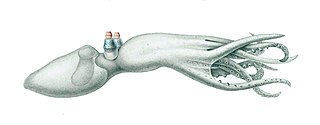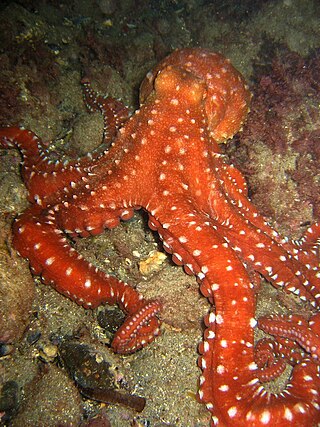
The hammerhead sharks are a group of sharks that form the family Sphyrnidae, named for the unusual and distinctive form of their heads, which are flattened and laterally extended into a cephalofoil. The shark's eyes are placed one on either end of this T-shaped structure, with their small mouths directly centered and underneath. Most hammerhead species are placed in the genus Sphyrna, while the winghead shark is placed in its own genus, Eusphyra. Many different— but not necessarily mutually exclusive—functions have been postulated for the cephalofoil, including sensory reception, manoeuvering, and prey manipulation. The cephalofoil gives the shark superior binocular vision and depth perception.

An octopus is a soft-bodied, eight-limbed mollusc of the order Octopoda. The order consists of some 300 species and is grouped within the class Cephalopoda with squids, cuttlefish, and nautiloids. Like other cephalopods, an octopus is bilaterally symmetric with two eyes and a beaked mouth at the centre point of the eight limbs. The soft body can radically alter its shape, enabling octopuses to squeeze through small gaps. They trail their eight appendages behind them as they swim. The siphon is used both for respiration and for locomotion, by expelling a jet of water. Octopuses have a complex nervous system and excellent sight, and are among the most intelligent and behaviourally diverse of all invertebrates.

Blue-ringed octopuses, comprising the genus Hapalochlaena, are four extremely venomous species of octopus that are found in tide pools and coral reefs in the Pacific and Indian oceans, from Japan to Australia. They can be identified by their yellowish skin and characteristic blue and black rings that can change color dramatically when the animal is threatened. They eat small crustaceans, including crabs, hermit crabs, shrimp, and other small sea animals.

Grimpoteuthis is a genus of pelagic cirrate (finned) octopods known as the dumbo octopuses. The name "dumbo" originates from their resemblance to the title character of Disney's 1941 film Dumbo, having two prominent ear-like fins which extend from the mantle above each eye. There are 17 species recognized in the genus. Prey include crustaceans, bivalves, worms and copepods. The average life span of various Grimpoteuthis species is 3–5 years.

Amphitretus is a genus of pelagic gelatinous octopuses. It is the sole genus of subfamily Amphitretinae, one of three subfamilies in the family Amphitretidae and consists of two species. Some authorities consider Amphitretus thielei as a subspecies of Amphitretus pelagicus, which would make the genus monotypic.

Opisthoteuthis californiana, also known as the flapjack octopus, or flapjack devilfish is a species of umbrella octopus.

Steller's sea eagle, also known as Pacific sea eagle or white-shouldered eagle, is a very large diurnal bird of prey in the family Accipitridae. It was described first by Peter Simon Pallas in 1811. No subspecies are recognised. A sturdy eagle, it has dark brown plumage with white wings and tail, a yellow beak, and yellow talons. Typically, it is the heaviest eagle in the world, at about 5 to 10 kg, but in some standard measurements, may be ranked below the harpy eagle and the Philippine eagle. Steller's sea eagle females are bigger than males.

The giant Pacific octopus, also known as the North Pacific giant octopus, is a large marine cephalopod belonging to the genus Enteroctopus and Enteroctopodidae family. Its spatial distribution encompasses much of the coastal North Pacific, from the Mexican state of Baja California, north along the United States' West Coast, and British Columbia, Canada; across the northern Pacific to the Russian Far East, south to the East China Sea, the Yellow Sea, the Sea of Japan, Japan's Pacific east coast, and around the Korean Peninsula. It can be found from the intertidal zone down to 2,000 m (6,600 ft), and is best-adapted to colder, oxygen- and nutrient-rich waters. It is the largest octopus species on earth and can often be found in aquariums and research facilities in addition to the ocean. E. dofleini play an important role in maintaining the health and biodiversity of deep sea ecosystems, cognitive research, and the fishing industry.

The pelagic thresher is a species of thresher shark, family Alopiidae; this group of sharks is characterized by the greatly elongated upper lobes of their caudal fins. The pelagic thresher occurs in the tropical and subtropical waters of the Indian and Pacific Oceans, usually far from shore, but occasionally entering coastal habitats. It is often confused with the common thresher, even in professional publications, but can be distinguished by the dark, rather than white, color over the bases of its pectoral fins. The smallest of the three thresher species, the pelagic thresher typically measures 3 m (10 ft) long.

Octopus cyanea, also known as the big blue octopus or day octopus, is an octopus in the family Octopodidae. It occurs in both the Pacific and Indian Oceans, from Hawaii to the eastern coast of Africa. O. cyanea grows to 16 cm in mantle length with arms to at least 80 cm. This octopus was described initially by the British zoologist John Edward Gray in 1849; the type specimen was collected off Australia and is at the Natural History Museum in London.

Pteropus pelagicus is a species of fruit bat in the family Pteropodidae. It includes two subspecies that were formerly recognized as full species— Pteropus insularis and Pteropus phaeocephalus. It is endemic to Micronesia. It is threatened by habitat loss.

Callistoctopus macropus, also known as the Atlantic white-spotted octopus, white-spotted octopus, grass octopus or grass scuttle, is a species of octopus found in shallow areas of the Mediterranean Sea, the warmer parts of the eastern and western Atlantic Ocean, the Caribbean Sea, and the Indo-Pacific region. This octopus feeds on small organisms which lurk among the branches of corals.

The seven-arm octopus, also known as the blob octopus or sometimes called septopus, is one of the two largest known species of octopus; the largest specimen ever discovered had an estimated total length of 3.5 m (11 ft) and mass of 75 kg (165 lb). The only other similarly large extant species is the giant Pacific octopus, Enteroctopus dofleini.

Octopus tetricus, the gloomy octopus or the common Sydney octopus, is a species of octopus from the subtropical waters of eastern Australia and New Zealand. O.tetricus belongs to the Octopus vulgaris species group and is a commercially prized species. All species within the O. vulgaris group are similar in morphology. The English translation of O. tetricus (Latin) is 'the gloomy octopus'.
Octopus wolfi, the star-sucker pygmy octopus, is the smallest known octopus. It is found in fairly shallow waters in the western Pacific. It is characterised by a pattern of "papillate fringes" around the edge of the suckers near the arm tip.

Vitreledonella is a genus of mesopelagic octopods from the family Amphitretidae which contains two species, one of which is the glass octopus.
Cirroctopus hochbergi is a cirrate octopus living between 800 and 1,070 meters deep off the coast of New Zealand. The species is known from 48 specimens. It is most similar to its sister taxon, Cirroctopus mawsoni; however, C. mawsoni's ventral pigmentation is lighter, and the two species have been found in very different areas.
Grimpoteuthis abyssicola, commonly known as the red jellyhead, is a species of small deep-sea octopus known from two specimens. The holotype specimen was a female collected on the Lord Howe Rise, between 3154 and 3180 meters depth. A second specimen was collected on the continental slope of south-eastern Australia between 2821 and 2687 m depth.
Grimpoteuthis innominata, commonly known as the small jellyhead, is a species of small, pelagic octopus described by Steve O'Shea in 1999 from two specimens, however several further specimens have since been identified. The genus Enigmateuthis was described to contain this species when described, but Martin Collins placed the species in the genus Grimpoteuthis due to uncertainty regarding the type specimen of Grimpoteuthis.

Opisthoteuthis chathamensis, commonly known as the roughy umbrella octopus, is a species of cirrate octopus restricted to demersal habitats surrounding the Chatham Rise in New Zealand. It is commonly known as the roughy umbrella octopus.

















